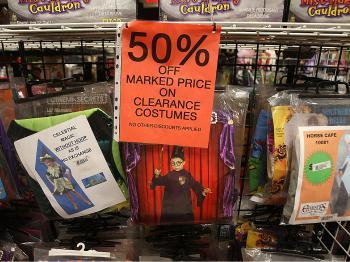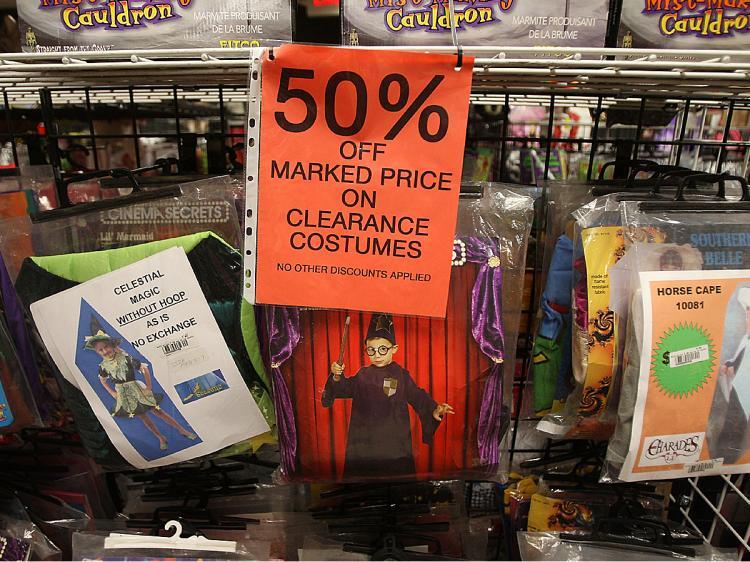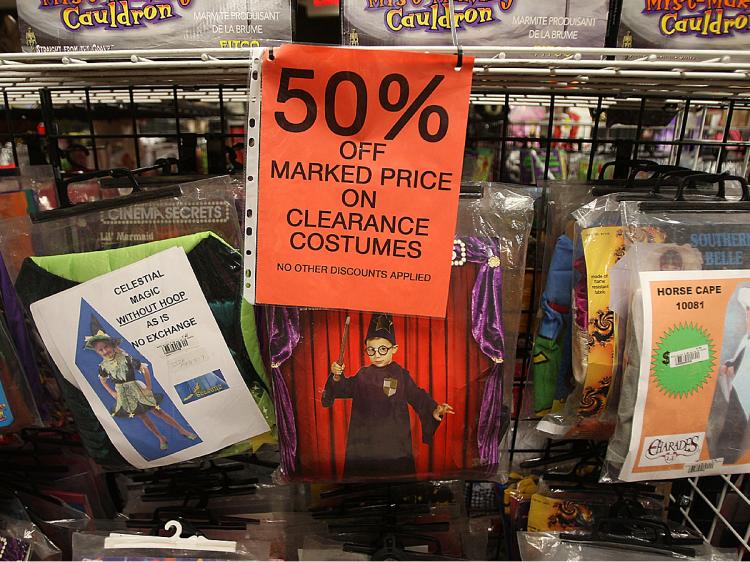Nervous retailers are cautiously keeping an eye on Halloween shopping as a prediction of the 2009 holiday shopping season, but the bad news is that analysts predict that shopping for Halloween costumes and party supplies this year will take a 15 percent hit from 2008.
“The largest majority (88.0 per cent) plan to spend less overall,” the National Retail Federation (NRF), a global retail trade organization, said in a survey. “Others say they will be buying less candy (46.5 per cent), using last year’s decorations without buying new ones (35.4 per cent), making costumes instead of purchasing them (16.8 per cent), reusing last year’s costumes (15.8 per cent), and not participating in as many Halloween activities such as haunted houses or fall festivals (26.4 per cent).”
Even the carved pumpkin, the all-American Halloween symbol, will lose out due to economic realities. Fewer Americans will buy new pumpkins this year, NRF found.
Due to employment losses, reduction of pocket money, and budget tightening, 18–24 year olds are curtailing Halloween spending by 21 per cent.
“The overriding theme for Americans’ Halloween celebrations this year will be, ‘How creative can I be, and how little can I spend?’” Phil Rist, vice president at BIGresearch said in an NRF press release.
Most Americans still love witch and even vampire costumes, but will try to make the costume by hand, experts said. Vampire costumes have become the hot item, NRF claims. Most likely, the multitude of vampire television shows and movies over the past year has a lot to do with this trend.
“Pop culture always influences Halloween costumes, and it will be interesting to see how creative Americans can get this year,” said Tracy Mullin, president and CEO at NRF.
Holiday Shopping Less Gloomy Than in 2008
Consumers will continue to spend their hard-earned dollars in 2009, but will be far more frugal, spend at a lesser rate than in 2008, and be highly selective in what they buy.
“Americans will focus primarily on practical gifts and shop on a budget this holiday season,” Rosalind Wells, chief economist at NRF, said in a statement.
NRF predicts less than one percent decline in holiday shopping, from $442 billion to $438 billion, compared with 2008. But retailer discounts won’t lure customers to the stores for early holiday shopping.
According to a recently published report by American Express Co., 69 per cent of those surveyed said a department store discount would not motivate them to shop early for the holidays.
Retailers are less willing to reduce merchandise to levels seen in 2008. To reduce cost, retailers expect shoppers to find less customer friendliness, a smaller sales force, less holiday decorations, a smaller merchandise selection, and definitely fewer or no discounts.
In 2008, retailers hired 63 per cent less holiday sales people than in 2007, and the lowest since before 1998. Even in 2003 and 2005, more than 450,000 seasonal workers were hired, according to the NRF “2009 Holiday Survival Kit.”
“Don’t bank on deep discounts,” NRF quoted the Saks Inc. CEO on its Web site.
Holiday Shopping Predictions Abound
“Americans continue to save at historically high rates while also paying down debt, and these factors combined suggest another chilly holiday season for retailers,” Carl Steidtmann, chief economist at Deloitte Services LLP said in a statement.
The Deloitte survey suggests “flat sales,” with total holiday revenues hovering around $810 billion.
In the same survey, Deloitte discovered that retailers are reducing inventories, keeping strict control over pricing and expenses, and holding advertising to a minimum.
Retailers that sell electronic merchandise can expect improvement in their sales, while others with general consumer products will see a decline, leaving the total year-end financial receipts at an unexciting level.
Deloitte advises retailers to take advantage of social networking, including Twitter and Facebook, Classmates.com, Vox, and many others that have sprung up over the past years.
Clothing retailers will see a 2 per cent decline, but still an improvement over last year’s 9 percent decline. Also, mass product retailers will see a 2.5 per cent increase in merchandise sales, according to Retail Forward, a retail research firm.
Just as Deloitte, Burst Media, Nielsen Company, and Retail Forward all predict somewhat flat sales for the holiday shopping season, the NPD Group found in its survey that sales will probably drop by a steep 4 percent.
“Perhaps the biggest X-mas X-factor [the number of variables affecting the holiday sales] is the overall state of U.S. consumers’ psyche. Will they be feeling frugal or will they have a case of frugal fatigue and unleash some pent-up demand?” Marshal Cohen, chief industry analyst of the NPD Group Inc., explained in a statement.
Holiday sales increased by 8.2 per cent between 1998 and 1999 and nosedived to 2.2 per cent by 2001, moving up again to between 6 and 7 per cent from 2003 to 2005 and nose diving again starting with 2006, with the worst in 2008 (a negative 4.5 per ent).
More than 60 per cent of Americans live from paycheck to paycheck, CareerBuilder.com determined from a recent survey, putting increasing pressure on retailers to hit their sales targets.
“The results of this study do not bode well for any retailers other than supermarkets, gas stations or discount specialists and mass merchandisers,” suggested CareerBuilder in a recent press release.
The younger generation will continue to spend on their wardrobe, dining out, and taking a trip, while the older generation will maintain the same level of spending as in prior months.
“There has been a shift in how consumers are expressing their wants and needs … I don’t think anyone expects the American consumer to quickly return to the spending levels of the last few years, but amid their cautiousness, we are seeing some areas where people are willing to increase spending,” Pamela Codispoti, senior vice president and general manager at American Express, said in a statement.
“The largest majority (88.0 per cent) plan to spend less overall,” the National Retail Federation (NRF), a global retail trade organization, said in a survey. “Others say they will be buying less candy (46.5 per cent), using last year’s decorations without buying new ones (35.4 per cent), making costumes instead of purchasing them (16.8 per cent), reusing last year’s costumes (15.8 per cent), and not participating in as many Halloween activities such as haunted houses or fall festivals (26.4 per cent).”
Even the carved pumpkin, the all-American Halloween symbol, will lose out due to economic realities. Fewer Americans will buy new pumpkins this year, NRF found.
Due to employment losses, reduction of pocket money, and budget tightening, 18–24 year olds are curtailing Halloween spending by 21 per cent.
“The overriding theme for Americans’ Halloween celebrations this year will be, ‘How creative can I be, and how little can I spend?’” Phil Rist, vice president at BIGresearch said in an NRF press release.
Most Americans still love witch and even vampire costumes, but will try to make the costume by hand, experts said. Vampire costumes have become the hot item, NRF claims. Most likely, the multitude of vampire television shows and movies over the past year has a lot to do with this trend.
“Pop culture always influences Halloween costumes, and it will be interesting to see how creative Americans can get this year,” said Tracy Mullin, president and CEO at NRF.
Holiday Shopping Less Gloomy Than in 2008
Consumers will continue to spend their hard-earned dollars in 2009, but will be far more frugal, spend at a lesser rate than in 2008, and be highly selective in what they buy.
“Americans will focus primarily on practical gifts and shop on a budget this holiday season,” Rosalind Wells, chief economist at NRF, said in a statement.
NRF predicts less than one percent decline in holiday shopping, from $442 billion to $438 billion, compared with 2008. But retailer discounts won’t lure customers to the stores for early holiday shopping.
According to a recently published report by American Express Co., 69 per cent of those surveyed said a department store discount would not motivate them to shop early for the holidays.
Retailers are less willing to reduce merchandise to levels seen in 2008. To reduce cost, retailers expect shoppers to find less customer friendliness, a smaller sales force, less holiday decorations, a smaller merchandise selection, and definitely fewer or no discounts.
In 2008, retailers hired 63 per cent less holiday sales people than in 2007, and the lowest since before 1998. Even in 2003 and 2005, more than 450,000 seasonal workers were hired, according to the NRF “2009 Holiday Survival Kit.”
“Don’t bank on deep discounts,” NRF quoted the Saks Inc. CEO on its Web site.
Holiday Shopping Predictions Abound
“Americans continue to save at historically high rates while also paying down debt, and these factors combined suggest another chilly holiday season for retailers,” Carl Steidtmann, chief economist at Deloitte Services LLP said in a statement.
The Deloitte survey suggests “flat sales,” with total holiday revenues hovering around $810 billion.
In the same survey, Deloitte discovered that retailers are reducing inventories, keeping strict control over pricing and expenses, and holding advertising to a minimum.
Retailers that sell electronic merchandise can expect improvement in their sales, while others with general consumer products will see a decline, leaving the total year-end financial receipts at an unexciting level.
Deloitte advises retailers to take advantage of social networking, including Twitter and Facebook, Classmates.com, Vox, and many others that have sprung up over the past years.
Clothing retailers will see a 2 per cent decline, but still an improvement over last year’s 9 percent decline. Also, mass product retailers will see a 2.5 per cent increase in merchandise sales, according to Retail Forward, a retail research firm.
Just as Deloitte, Burst Media, Nielsen Company, and Retail Forward all predict somewhat flat sales for the holiday shopping season, the NPD Group found in its survey that sales will probably drop by a steep 4 percent.
“Perhaps the biggest X-mas X-factor [the number of variables affecting the holiday sales] is the overall state of U.S. consumers’ psyche. Will they be feeling frugal or will they have a case of frugal fatigue and unleash some pent-up demand?” Marshal Cohen, chief industry analyst of the NPD Group Inc., explained in a statement.
Holiday sales increased by 8.2 per cent between 1998 and 1999 and nosedived to 2.2 per cent by 2001, moving up again to between 6 and 7 per cent from 2003 to 2005 and nose diving again starting with 2006, with the worst in 2008 (a negative 4.5 per ent).
More than 60 per cent of Americans live from paycheck to paycheck, CareerBuilder.com determined from a recent survey, putting increasing pressure on retailers to hit their sales targets.
“The results of this study do not bode well for any retailers other than supermarkets, gas stations or discount specialists and mass merchandisers,” suggested CareerBuilder in a recent press release.
The younger generation will continue to spend on their wardrobe, dining out, and taking a trip, while the older generation will maintain the same level of spending as in prior months.
“There has been a shift in how consumers are expressing their wants and needs … I don’t think anyone expects the American consumer to quickly return to the spending levels of the last few years, but amid their cautiousness, we are seeing some areas where people are willing to increase spending,” Pamela Codispoti, senior vice president and general manager at American Express, said in a statement.






